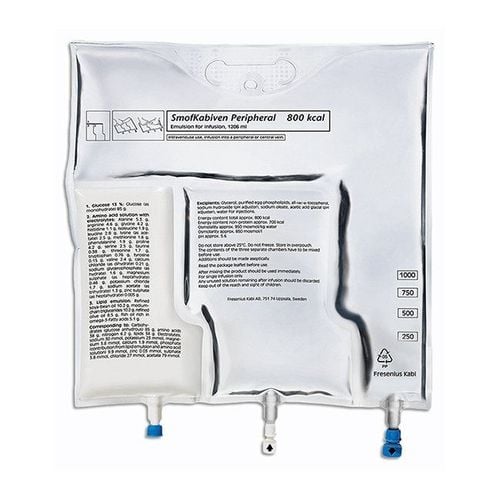This is an automatically translated article.
Most of us are consuming more omega-6 fatty acids and less omega-3 fatty acids, resulting in a disparate Omega 6 and Omega 3 ratio. The reason for the imbalance of this ratio may be due to the Western diet.
1. How important are Omega-6 and Omega-3 fatty acids?
In terms of chemical structure, omega-6 and omega-3 fatty acids contain many double bonds, so they are also called polyunsaturated substances. The human body does not have the enzymes to produce these poly fats, so it must be obtained from food. Without omega-6 and omega-3, the body will be deficient in nutrients and become ill. So these are essential fatty acids for the body. However, biologically, unlike other fats that perform the task of providing or storing energy, omega-6 and omega-3 play a very important role in the body, participating in the inflammation and blood clotting. In particular, omega-6 is known to cause inflammation, while omega-3 is considered anti-inflammatory.
To avoid infection and not get hurt, the body creates an inflammatory response. However, inflammation can cause serious damage and lead to chronic inflammation, which can even cause diseases like diabetes, heart disease, arthritis, metabolic syndrome, Alzheimer's and cancer.
A diet that is too high in omega-6 fatty acids and low in omega-3s is thought to increase inflammatory syndrome and if eaten in balance each will help reduce inflammation.
2. How much Omega-6 fatty acids do non-industrial people consume?
Non-industrial people have an omega 6 to omega 3 ratio equivalent to 4:1 - 1:4. Those who mainly eat meat have this ratio between 2:1 - 4:1, while those who eat a lot of seafood have this ratio of 1:4. To evolve, humans have reached this ratio of 1:1. Today, however, the ratio among people living in the industrial age is 16:1.
Although non-industrial people have a lower life expectancy than today, they are less likely to suffer from chronic diseases such as diabetes and heart disease than those caused by unhealthy modern lifestyles.
To get that optimal ratio, non-industrial people ate less omega-6 fatty acids, exercised more, consumed less sugary foods and fast food and junk food. However, using only omega 6 to measure their health is not effective.
MORE: Omega-3-6-9 Fatty Acids: A Complete Overview

Người dân phi công nghiệp có tỷ lệ Omega 6 cao hơn Omega 3
3. Western Diet and Fatty Acid Consumption
Currently, people in Western countries are consuming a large amount of nuts and oils of plant origin, which are rich in omega-6 fatty acids. However, it is important to know the history of processing technology that they have not appeared for about a century. So, genetically, humans have not been able to adapt to a high omega-6 diet.
Among the cooking oils being consumed, soybean oil is rich in omega-6 fatty acids and is used to prepare a variety of fast foods. Eating a lot of these foods has been changing the amount of fat stored in the body and cell membranes.
If cell membranes have too much omega-6 fatty acids can increase the risk of heart disease. However, there are still no quality and controlled studies investigating the impact of omega-6 acids on heart disease. Meanwhile, controlled studies show that another common omega-6 fatty acid does not increase markers of inflammation.
To date, studies demonstrating an association between omega-6 fatty acids and the risk of chronic lifestyle-related diseases have not been elucidated. On the other hand, a lot of evidence supports the positive effects of omega-3 fatty acids on health, e.g. cardiovascular health benefits, improvement of mental disorders. However, some research has also suggested that consuming too much fatty acids like omega-3 and omega-6 can create an opportunity for the anti-bonds present in polyunsaturated fats to react with oxygen and form a chemical compound. chain reactions of free radicals, causing cell damage and aging as well as the cause of cancer initiation.
If you want to improve the ratio of omega 6 to omega 3, you need to eat more omega-3 to make up for the amount of omega 6 consumed, but it is best to eat a balance of both types in relatively low amounts.
4. Avoid excessive consumption of vegetable oils containing Omega-6 fatty acids
To optimize the ratio of Omega 6 , we need to avoid consuming vegetable and seed oils high in omega-6 as well as foods that use oils and seeds to be processed. Soybean, sunflower, and corn oils are known to contain high levels of omega-6, while olive oil, palm oil, coconut oil, and avocado are known to contain less omega-6.
With the current diet, the human body is storing a large amount of omega-6 fatty acids, so it takes a while to eliminate this fatty acid.

Omega 6 đem lại nhiều lợi ích nhưng cần cân bằng giữa Omega 3 và Omega 6
5. Eat more meat containing Omega-3 fatty acids
Cattle meat and seafood contain a lot of omega-3 fatty acids EPA and DHA good for the body. However, today, the food of these animals is made from cereals containing soybeans and corn.
If you want to reduce the amount of omega-6 fatty acids found in meat, choose leaner cuts of meat. Omega 3 is also found in eggs, however to choose eggs with high omega-3 content, avoid buying eggs from hens raised with grains.
To optimize the ratio of Omega 3, it is necessary to eat seafood, such as salmon, 1-2 times a week. If not, consider supplementing with fish oil to increase the amount of omega-3 in the body. In addition to meat and seafood, chia seeds and flaxseeds are also rich in omega-3s. However, they contain an omega-3 called ALA which is not good for health. Therefore, eating meat and seafood is considered a better choice to provide omega-3 for the body.
To optimize the ratio of Omega 6 and Omega 3 in the body, it is necessary to avoid consuming a lot of Omega 6 containing foods such as oils and nuts, and eat more Omega 3 containing foods to achieve a balanced ratio. .
Please dial HOTLINE for more information or register for an appointment HERE. Download MyVinmec app to make appointments faster and to manage your bookings easily.
Reference source: healthline.com













